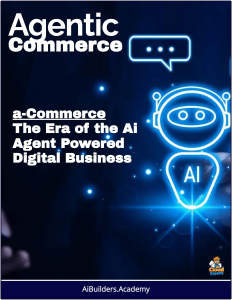Walmart: Exemplar Case Study for Enterprise Ai and Agentic Commerce
Walmart’s cloud strategy, combined with its 'Element' machine-learning platform, improves operational efficiency and customer engagement, positioning the retailer as a leader in "Cognitive Commerce".
 As Fortune describes Walmart leverages its extensive cloud network, specifically its “triplet model” multi-hybrid cloud, to power generative AI tools that enhance customer shopping experiences.
As Fortune describes Walmart leverages its extensive cloud network, specifically its “triplet model” multi-hybrid cloud, to power generative AI tools that enhance customer shopping experiences.
This infrastructure, consisting of two vendor-provided clouds and one private cloud across three U.S. locations, supports AI-driven features like a search tool, a shopping assistant, and exit technology.
These tools enable personalized product suggestions, voice ordering via smart devices, and efficient in-store operations.
Element – Enterprise Ai
Walmart’s cloud strategy, combined with its ‘Element‘ machine-learning platform, improves operational efficiency and customer engagement, positioning the retailer as a leader in cognitive commerce. This approach, termed “intellifusion,” integrates cloud and AI to transform retail, distinguishing Walmart from competitors like Amazon and Target.
Walmart’s Element is a flexible, in-house machine learning (ML) platform designed to streamline AI/ML adoption at scale, empowering data scientists and engineers to deliver innovative retail solutions.
Built from the ground up, Element uses a multi-cloud strategy with Kubernetes for container orchestration and a Machine Learning Operations (MLOps) framework, enabling rapid development, deployment, and monitoring of scalable ML models across multiple clouds.
The platform integrates best-of-breed technologies, reducing setup time and costs while enhancing productivity through seamless cloud-switching and standardized processes. Key applications include Market Intelligence, which uses ML for competitive pricing and assortment insights, and an intelligent driver dispatch system for optimizing last-mile delivery, cutting costs and improving delivery times.
Element supports Walmart’s massive operations, serving 240 million weekly customers across 10,500 stores and e-commerce sites in 19 countries, by simplifying workflows, fostering collaboration, and accelerating time-to-market for AI-driven solutions.
Intellifusion
Intellifusion, as highlighted in the Fortune article, represents Walmart’s innovative approach to transforming retail by seamlessly integrating cloud computing with artificial intelligence, particularly generative AI and machine learning.
This strategy, dubbed “intellifusion,” combines the computational power of a robust cloud infrastructure with intelligent systems to create a data-driven retail ecosystem that enhances both customer experiences and operational efficiency.
At its core, intellifusion leverages Walmart’s “triplet model” multi-hybrid cloud, which consists of two vendor-provided clouds and one private cloud hosted across three U.S. locations. This setup provides the scalability and processing power needed to support AI-driven applications that handle vast amounts of data in real time.
The fusion of cloud and AI enables Walmart to deliver highly personalized and efficient shopping experiences, a concept referred to as cognitive commerce. Through its Element machine-learning platform, Walmart powers tools like an advanced search engine, a shopping assistant, and exit technology.
Cognitive Commerce
For instance, a customer might use the app to ask for a birthday gift for a 10-year-old, and the AI, backed by the cloud, quickly analyzes product catalogs and user data to suggest tailored items like toys or games.
Simultaneously, the system can optimize in-store operations by alerting staff to restock popular products or streamlining checkouts with scan-and-go technology. These capabilities allow Walmart to anticipate customer needs and provide intuitive, seamless interactions across digital and physical channels.
By adopting intellifusion, Walmart gains a significant competitive edge over rivals like Amazon and Target. The approach not only enhances customer engagement through personalized recommendations and voice-based ordering via smart devices but also improves operational efficiency by optimizing supply chain management and inventory tracking.
At its core, cognitive commerce leverages AI to understand and predict customer behavior by analyzing vast amounts of data, such as purchase history, browsing patterns, and preferences.
For Walmart, this is enabled by its Element machine-learning platform and supported by a robust multi-hybrid cloud infrastructure. For example, when a customer uses Walmart’s app or website to search for a product, the AI-powered search tool doesn’t just match keywords but interprets the intent behind the query, offering tailored suggestions.
A customer asking, “What’s a good gift for a 10-year-old’s birthday?” might receive recommendations for popular toys or games, curated based on real-time data and trends. This level of personalization makes shopping more relevant and engaging, fostering a deeper connection between the retailer and the customer.
Multi-Channel AI
Beyond personalization, cognitive commerce enhances the entire shopping journey by integrating AI across various touchpoints. Walmart’s shopping assistant, for instance, allows customers to place orders via voice commands on smart devices, making the process more convenient and accessible.
In physical stores, cognitive commerce powers technologies like exit systems or scan-and-go checkouts, which reduce friction and improve efficiency. These tools rely on AI to process data instantly, ensuring seamless experiences whether a customer is shopping online, through a mobile app, or in a brick-and-mortar store. By anticipating needs and simplifying interactions, cognitive commerce creates a fluid, customer-centric retail environment.
Operationally, cognitive commerce enables Walmart to optimize its supply chain and inventory management. The AI systems, backed by the cloud’s scalability, can predict demand, alert staff to restock high-demand items, or adjust logistics in real time to meet customer expectations. This not only reduces costs but also ensures products are available when and where customers want them. The term “cognitive” reflects the system’s ability to “think” and adapt dynamically, much like a human brain, by learning from data and improving over time.
In a broader sense, cognitive commerce sets Walmart apart from competitors like Amazon and Target by positioning it as a leader in retail innovation. It transforms shopping into a proactive, intelligent process where the retailer anticipates customer needs rather than merely reacting to them.
By blending AI’s predictive capabilities with the computational power of the cloud, Walmart’s cognitive commerce strategy, as part of its broader “intellifusion” approach, redefines retail as a smarter, more connected experience that benefits both customers and the business.



